By: Johannes Korbmacher
Many-valued logics
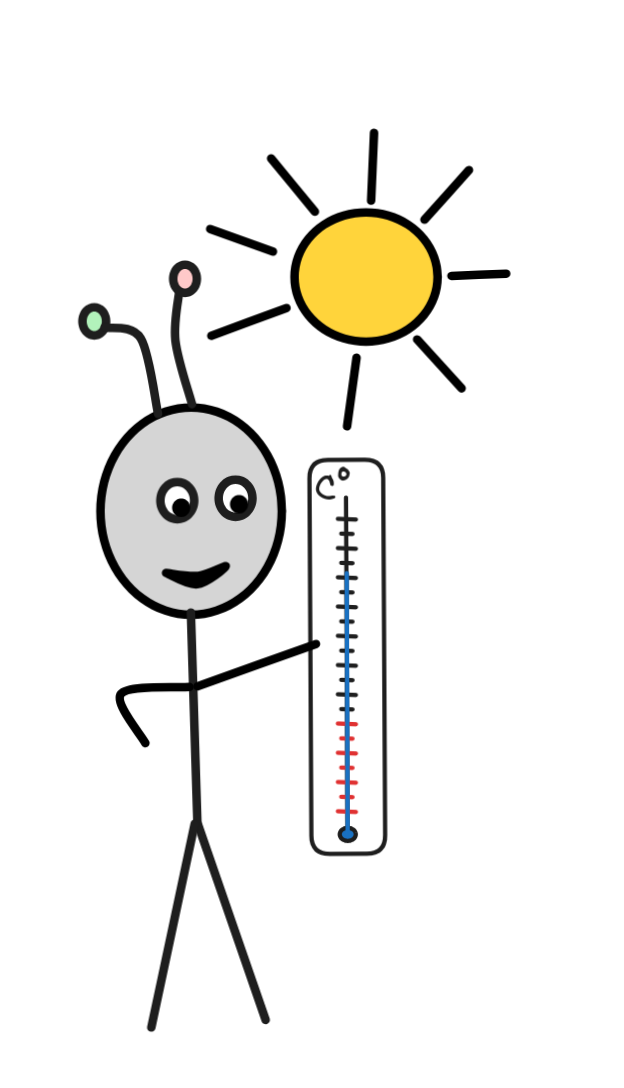 In classical logic, we assume that every formula is either true or false. This
is known as the
principle of
bivalence. While the
assumption is valid in many contexts, it is clearly an
idealization
in others. Think of statements about the future, like “it will rain tomorrow”.
Unless you’re a die-hard
fatalist, you
probably don’t think that statement is true or false now—its truth or falsity
will be decided tomorrow. Or think about
vague concepts, like warmth. Is
25°C warm? What about 21, 20, 19°C? Is there a clear cut-off point? If so,
where? Is it at 20°C, maybe? Does that then mean that 19.999°C is no longer
warm?—It seems that warmth is something that comes in degrees: 25°C is warmer
than 22°C is warmer than 19°C. Examples like these motivate the study of
many-valued
logics, which abandon
bivalence.
In classical logic, we assume that every formula is either true or false. This
is known as the
principle of
bivalence. While the
assumption is valid in many contexts, it is clearly an
idealization
in others. Think of statements about the future, like “it will rain tomorrow”.
Unless you’re a die-hard
fatalist, you
probably don’t think that statement is true or false now—its truth or falsity
will be decided tomorrow. Or think about
vague concepts, like warmth. Is
25°C warm? What about 21, 20, 19°C? Is there a clear cut-off point? If so,
where? Is it at 20°C, maybe? Does that then mean that 19.999°C is no longer
warm?—It seems that warmth is something that comes in degrees: 25°C is warmer
than 22°C is warmer than 19°C. Examples like these motivate the study of
many-valued
logics, which abandon
bivalence.
It turns out that non-bivalent reasoning is relevant in many different AI contexts. Just think of reasoning with incomplete information or robotic sensing. In this chapter, we’ll explore two non-bivalent reasoning systems, which are particularly important in AI-research:
-
the 3-valued logic of Kleene, and
-
the infinitely many valued fuzzy logic of Łukasiewicz.
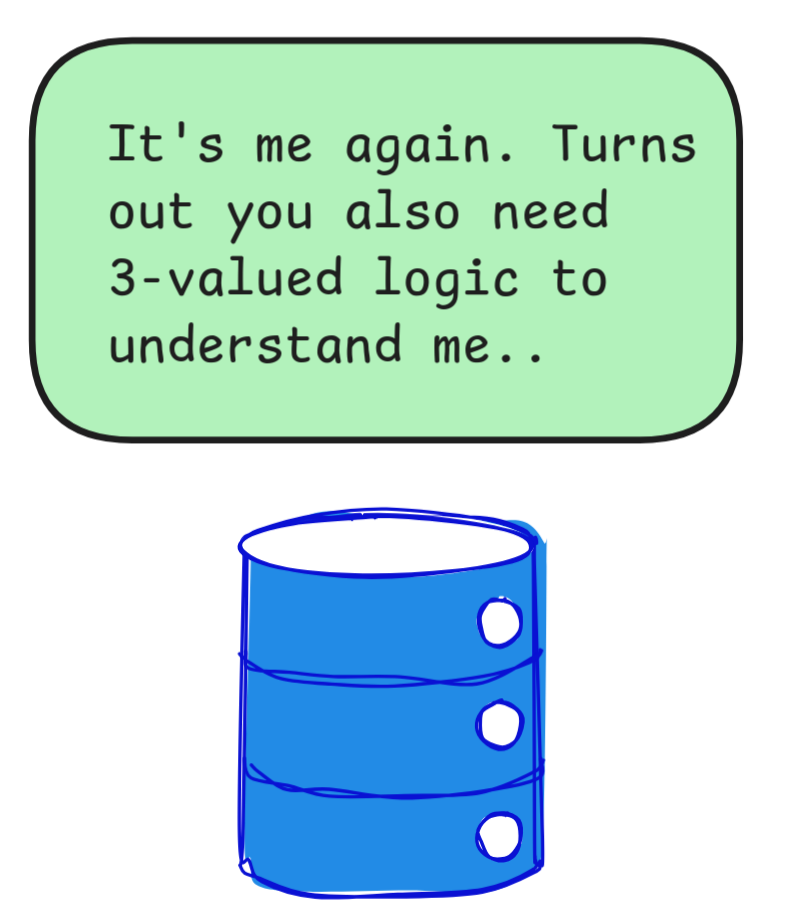 As you will see, these systems figure in AI-technologies in different ways.
We’ll see how Kleene’s logic, for example, is the basis for how
As you will see, these systems figure in AI-technologies in different ways.
We’ll see how Kleene’s logic, for example, is the basis for how SQL handles
incomplete information, while fuzzy logic is used in industry products such as
Automatic Train
Control-systems for
subway trains.
Of course, we’ll only be able to scratch the surface of the field of many-valued
logics, but you’ll add some very useful techniques and insights to your logical
toolbox.
At the end of the chapter, you will be able to:
-
explain the 3-valued Kleene truth-tables for negation, conjunction, and disjunction and their relevance to DBs
-
test inferences for validity in Kleene’s 3-valued logic using a truth-table method
-
explain the infinitely-valued Zadeh-operators for interpreting the negations, conjunctions, and disjunctions of fuzzy propositional variables
-
formulate fuzzy rules to describe the interaction of fuzzy propositional variables, and explain their relevance to AI-systems.
Kleene Algebra
Recall our simply country DB from when we explored the relation between open FOL formulas and SQL queries. The content of the DB was given by the following tables:
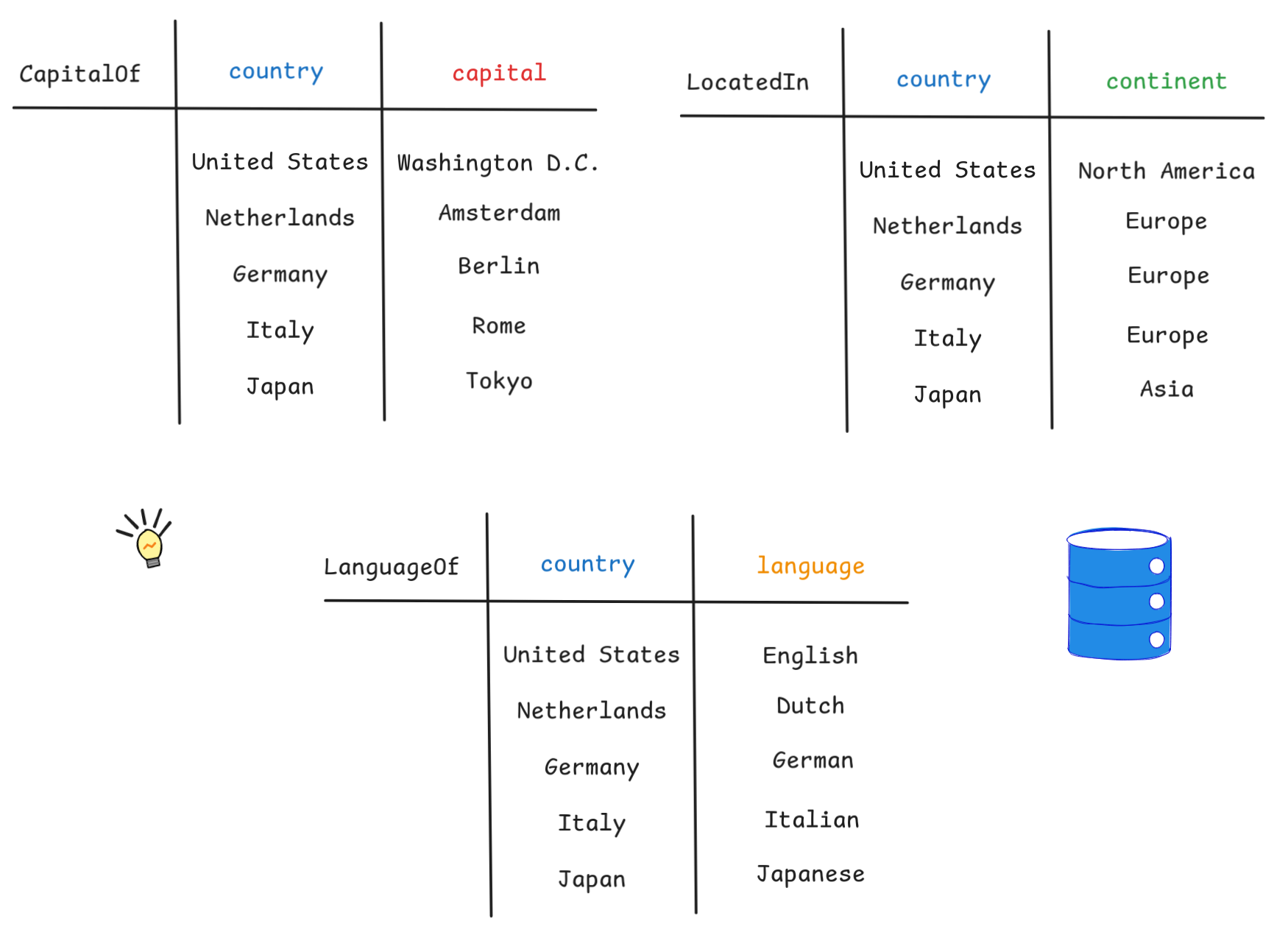
Now suppose that we learn of a new country. Let’s take Zimbabwe, for example,
which is located in Africa and whose capital is Harare. But let’s suppose we
don’t know which
language(s) are spoken in
Zimbabwe. In SQL, we can
INSERT this information into our DB using the
special marker
NULL
represent the “missing” information like so:
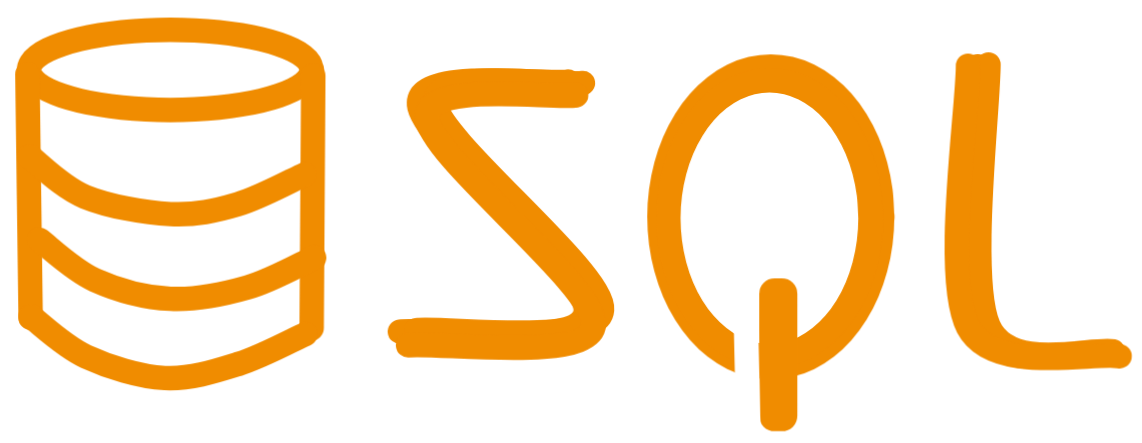
|
|
Now, let’s query the database and to ask for the countries which speak Dutch. Following the ideas we’ve discussed before, we can do this with the following query:

|
|
The return value is, as expected, the table with the single row Netherlands:
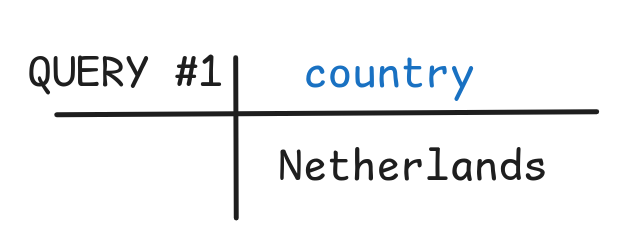
But now, let’s query our DB for the countries that dont speak Dutch:

|
|
The return values are all the countries of which we know that they speak a language other than Dutch:
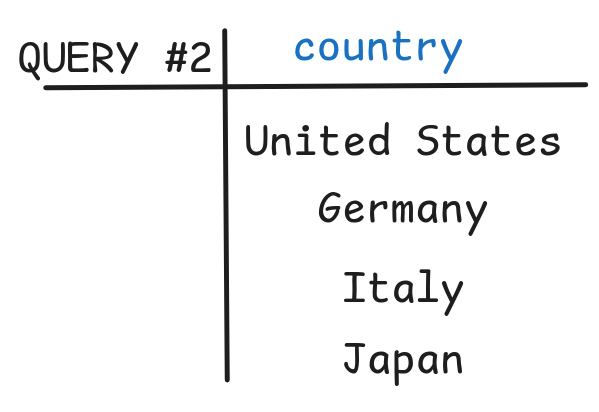
You can check this out yourself in our updated db-fiddle.
But what happened to Zimbabwe? It returns in none of the two queries and, in a sense, that’s to be expected: our DB doesn’t know whether they speak Dutch in Zimbabwe, so it neither returns the country as one where they do or where they don’t. But if we look at this from a logical perspective, things get a bit less clear.
Remember that SQL queries correspond to open FOL formulas and the return value
for a query is the extensions of the extension of the corresponding formula in
the model expressed by the DB. Now, in our toy example, QUERY #1 corresponds
to the following formula:
LanguageOf x dutch
In fact, the table above gives the extension of this predicate in our DB model.
A natural thought would be that the formula that corresponds to QUERY #2 is:
¬ LanguageOf x dutch
But something’s off here! Assuming classical logic, the fact that Zimbabwe
wasn’t returned for Query #1 means that the truth-value of LanguageOf
zimbabwe dutch is 0. In fact, our table doesn’t say that Dutch is the
language of Zimbabwe. But since in classical logic, we interpret ¬ via the
Boolean NOT, we have that:
¬ LanguageOf zimbabwe dutch = NOT v(LanguageOf zimbabwe dutch)
That means that:
¬ LanguageOf zimbabwe dutch = NOT v(LanguageOf zimbabwe dutch) = NOT 0
= 1
But QUERY #2 didn’t return Zimbabwe. So we seem to have
that Zimbabwe is neither in the extension of LanguageOf x dutch nor in the
extension of ¬ LanguageOf x dutch. Something went wrong.
What’s going on is that the NOT in our query is
simply not the negation of classical logic. In fact, it is the negation of
Kleene’s 3-valued logic, which is also known as K3.
By the way, note that there isn’t a contradiction here between the
correspondence we established earlier between open formulas of classical FOL and
SQL queries. In the construction we used in the exercises, we expressed negation
using a WHERE NOT EXISTS construction. In our
case, this would be:

|
|
If you copy and paste this code into our db-fiddle, you’ll see that this query does return Zimbabwe as expected.
So, let’s explore the basic theory of K3 from a logical perspective and look at some other applications. For the purpose of this chapter, we’ll restrict ourselves to propositional K3. It’s rather straight-forward to extend the ideas to FOL formulas and you’ll explore some of these ideas in the exercises.
K3 allows for three possibilities: a formula can be true, false, or
unknown, where the unknown truth-value corresponds to the SQL-marker NULL. The values true and false are represented as
1 and 0 as before. To represent the unknown value, we’ll use ω, which is
how NULL is typically represented in
database
theory. So, the Kleene
truth-values are:
{ 0, 1, ω }
Just like in Boolean algebra, there are different interpretations of these values. The interpretation we’ve been using so far is informational:
- the value
1represents the information that something is true, - the value
0represents the information that something is false, and - the value
ωrepresents the lack of information.
But other interpretations are possible, such as decided for, decided against,
undecided or high voltage, low voltage, intermediate voltage, etc. Even
completely different interpretations, where ω means both true and false are
possible. This leads to
paraconsistent
logic, which we won’t go
into the details of here.
Also the notion of truth-function generalizes nicely from Boolean algebra to our Kleene algebra: Kleene truth-functions are functions that take our three values as inputs and outputs.
The standard Kleene truth-functions are given by the following tables:
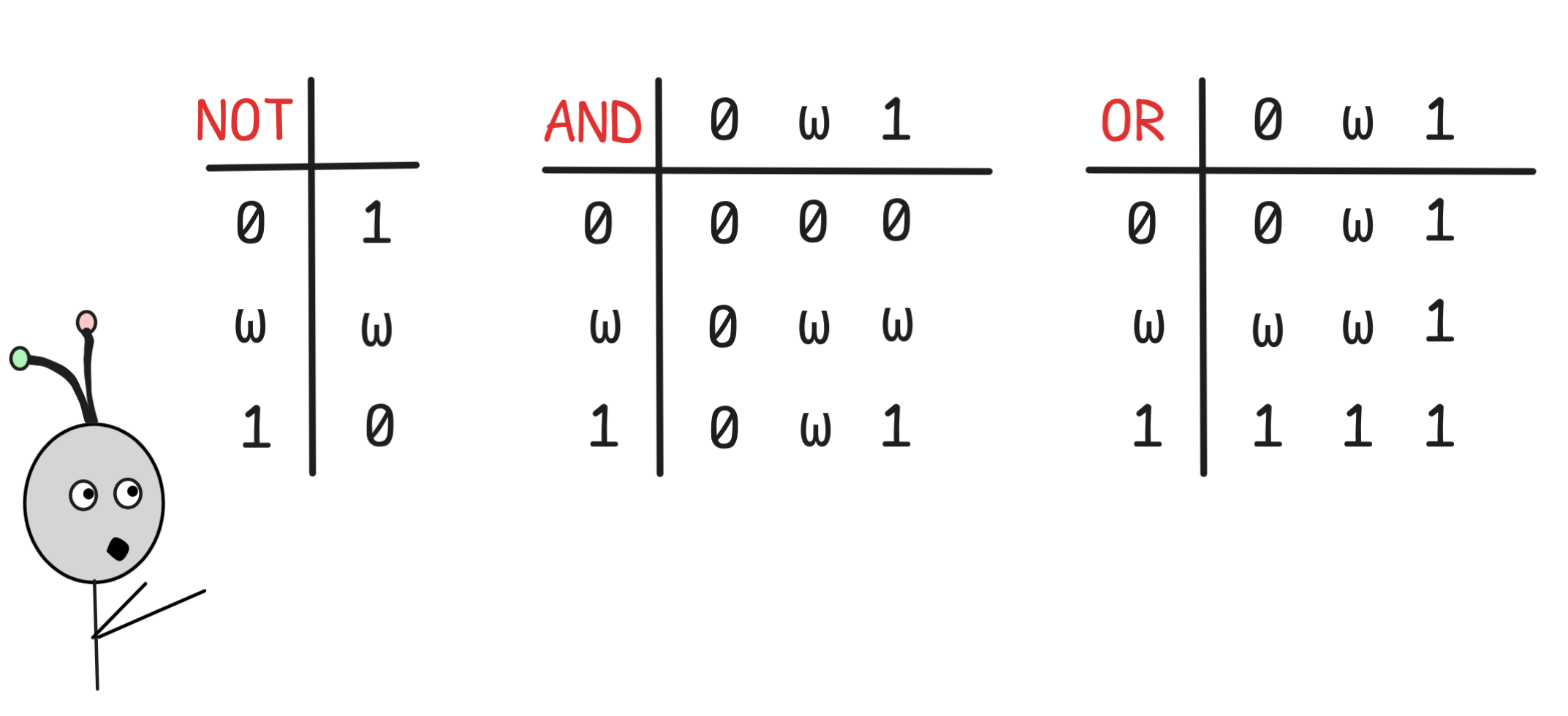
We denote these functions using NOT, AND, OR (in red) rather than NOT, AND, OR (in blue) to distinguish the Boolean from the Kleene truth-functions.
To understand the functions, our informational interpretation is helpful. For
example, if we have the information that a sentence is false, i.e. has value
0, this is enough information to know that it’s negation is true, so we set
NOT 0 = 1. But if we have no information about the sentence, i.e. value
ω, then this is not enough information to determine what the negation of that
sentence should be. In other words NOT ω = ω. This interpretation works
for all the other connectives: if the information about the inputs is enough to
determine the classical truth-value of the output, this is returned, otherwise
ω. Note that, in particular, if the inputs are classical truth-values 0 or
1, the output of any Kleene truth-function is the same as the output of the
corresponding Boolean function.
In contrast to Boolean algebra, in a Kleene setting, the functions NOT, AND, OR are not truth-functionally complete. To get a truth-functionally complete set, we need to add the following function, which is sometimes called the “definedness” function:
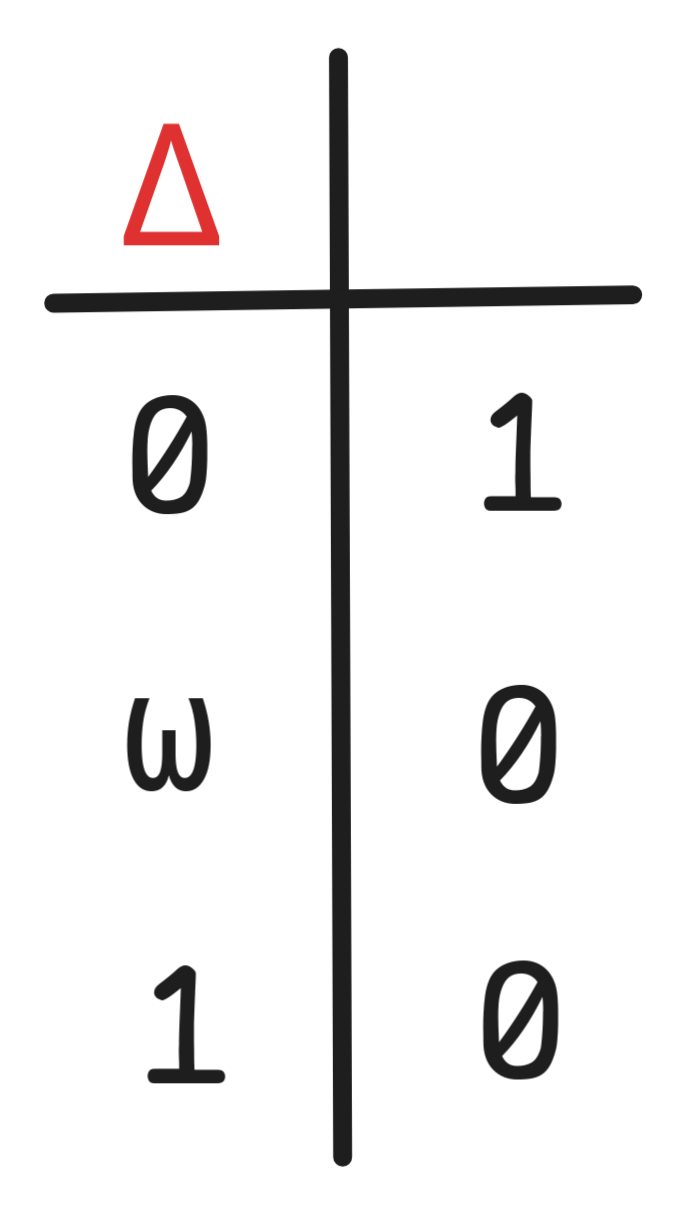
This function doesn’t play a huge practically role, but it cannot be expressed using NOT, AND, OR alone. But Δ together with NOT, AND, OR can express all possible Kleene truth-functions.
In Boolean algebra, we provided implementations of the Boolean truth-functions
using relay circuits. In Kleene logic, an implementation are SQL queries using
the SQL operations NOT, AND, OR. To show how
this works, let’s create a simple SQL DB that contains two tables, one for all
the Kleene values and one for all pairs of Kleene values:

|
|
In that DB, the following queries directly reproduce our Kleene truth-tables:

|
|
You can convince yourself by running the code in db-fiddle.
A cool little side-effect of this is that you can use SQL as a K3
SAT-solver, which is an idea you’ll explore in the exercises.
Just like in Boolean algebra, there are laws of Kleene algebra. Here’s a straight-forward
(X OR (Y OR Z)) = ((X OR Y) OR Z)(X AND (Y AND Z)) = ((X AND Y) AND Z) |
(“Associativity”) | |
(X OR Y) = (Y OR X)(X AND Y) = (Y AND X) |
(“Commutativity”) | |
(X OR (X AND Y)) = X(X AND (X OR Y)) = X |
(“Absorption”) | |
(X OR (Y AND Z)) = ((X OR Y) AND (X OR Z))(X AND (Y OR Z)) = ((X AND Y) OR (X AND Z)) |
(“Distributivity”) | |
(X OR 0) = X(X AND 1) = X |
(“Identity”) | |
(X AND 0) = 0(X OR 1) = 1 |
(“Domination”) | |
NOT (NOT X) = X |
(“Involution”) | |
NOT (X OR Y) = (NOT X) AND (NOT Y)NOT (X AND Y) = (NOT X) OR (NOT Y) |
(“De Morgan laws”) | |
(X AND NOT X) AND (Y OR NOT Y) = (X AND NOT X) |
(“Kleene condition”) |
This set of laws is a sound and complete axiomatization of Kleene algebras, that is we can derive all (and only) the laws of Kleene algebra from them.
Kleene Logic — K3
So far, we’ve been thinking about a low-level implementation of Kleene reasoning, viz. information retrieval from DB with incomplete information. But we can also use K3 for high-level deductive inference in situations with partial information or events with unknown outcomes, such as tomorrow’s weather.
In order to do so, we need to define the notion of a model in K3. Remember that a model is just a possible reasoning scenario. Following along with the information idea, we can think of the different reasoning scenarios as information states. So, if we have, for example, two propositional variables RAIN to say that it rains tomorrow and SUN to say that tomorrow the sun will shine, there are now 9 scenarios:
- We have the information that the sun will shine and that it will rain
- We have the information that the sun will shine and it won’t rain
- We have the information that the sun will shine but no information about rain
- We have the information that the sun won’t shine and that it will rain
- We have the information that the sun won’t shine and it won’t rain
- We have the information that the sun won’t shine but no information about rain
- We have no information about the sun but that it will rain
- We have no information about the sun but that it won’t rain
- We have no information about either the sun or the rain
That is, logical space looks something like this:
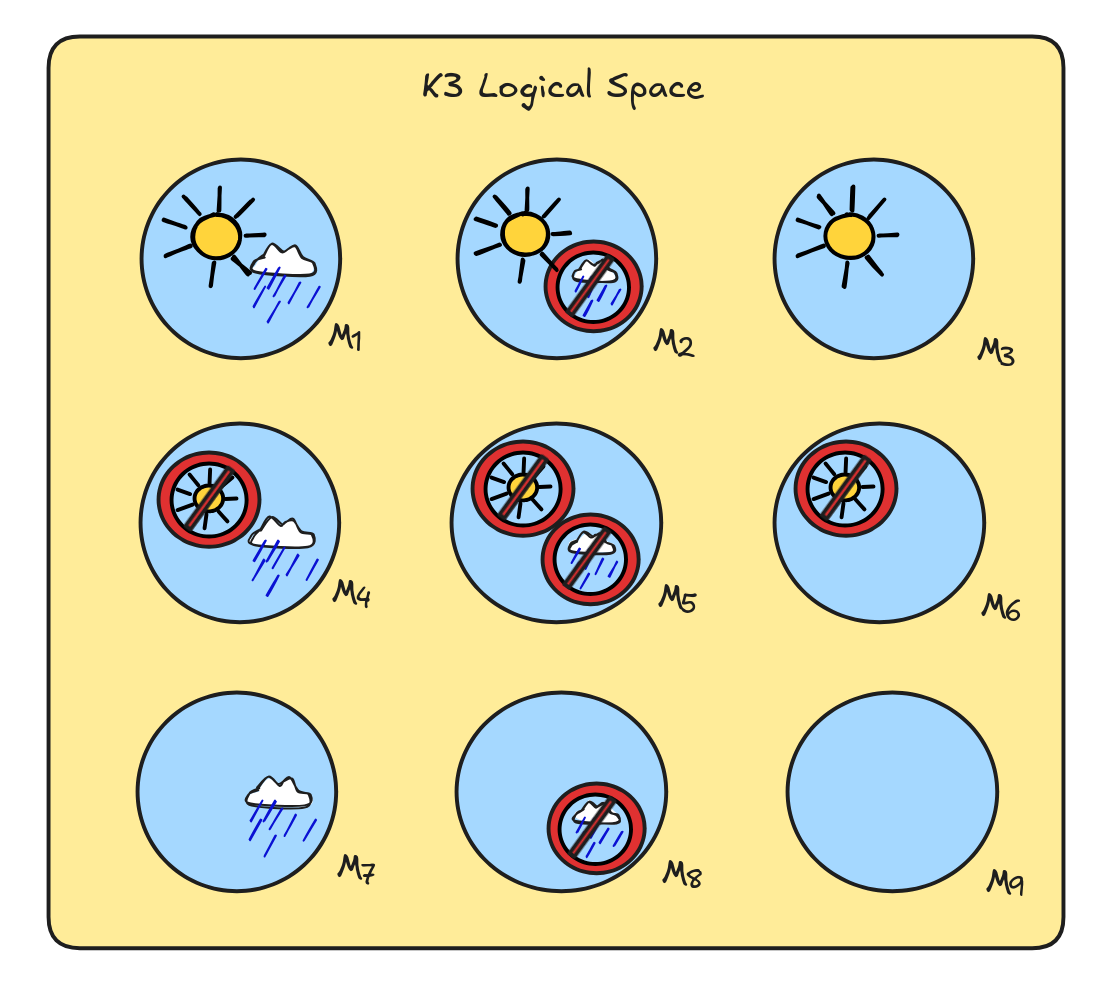
Following essentially the same idea as in Boolean algebra, we can think of each
of these scenarios as a function from the propositional variables into the
Kleene truth-values. The information state 1., for example, corresponds to the
function that assigns both SUN and RAIN the value 1, while state 3.
assings SUN the value 1 and RAIN the value ω. So, we can write v(A)
just like before, just that v(A)
rather than just  { 0, 1, ω }
{ 0, 1, ω }{0,
1}.
The truth-values for complex formulas, then are calculated using the K3 truth-functions in the obvious way:
 A) = NOT v(A)
A) = NOT v(A) B) = v(A) AND v(A)
B) = v(A) AND v(A)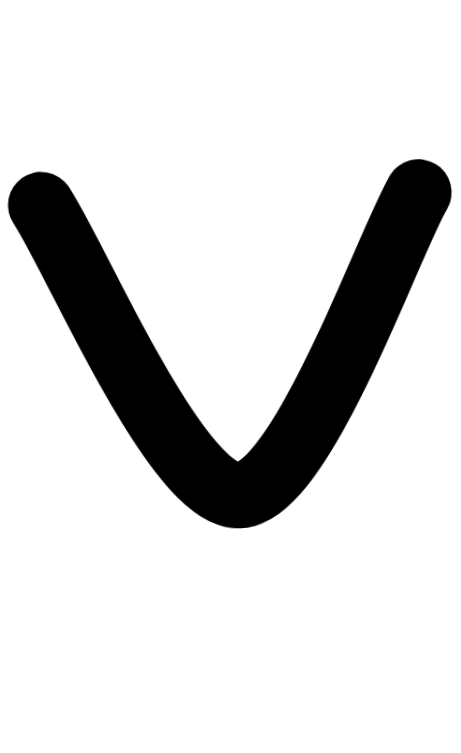 B) = v(A) OR v(A)
B) = v(A) OR v(A)Correspondingly, we also get the notion of a proposition expressed by a formula. In fact, the following definition works just like before:
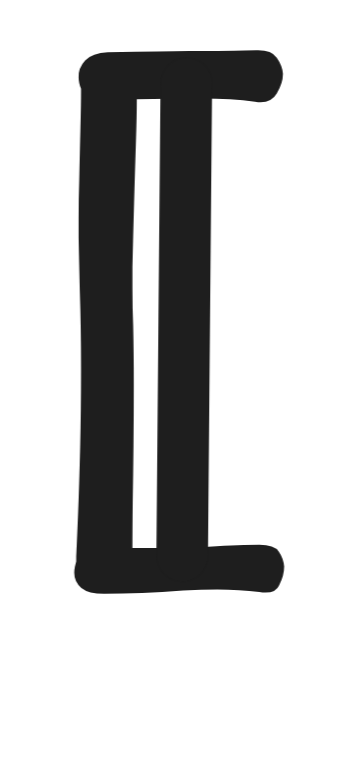
A
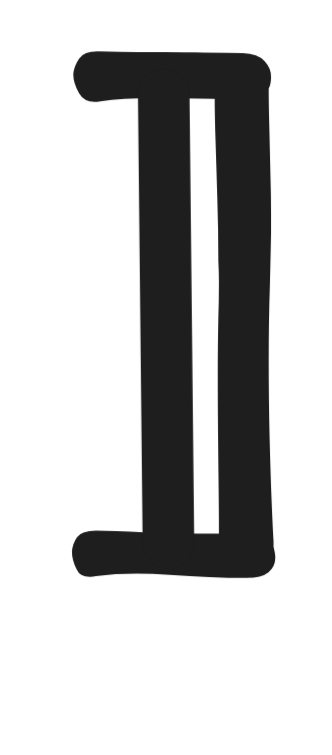 = { M :
= { M : A is true in M }These propositions are a bit “bigger” than the classical propositions, since
there are now more models, but otherwise things work like in classical logic.
Here are, for example, the propositions

 SUN
SUN
 and
and
 SUN
SUN
 RAIN
RAIN
 :
:
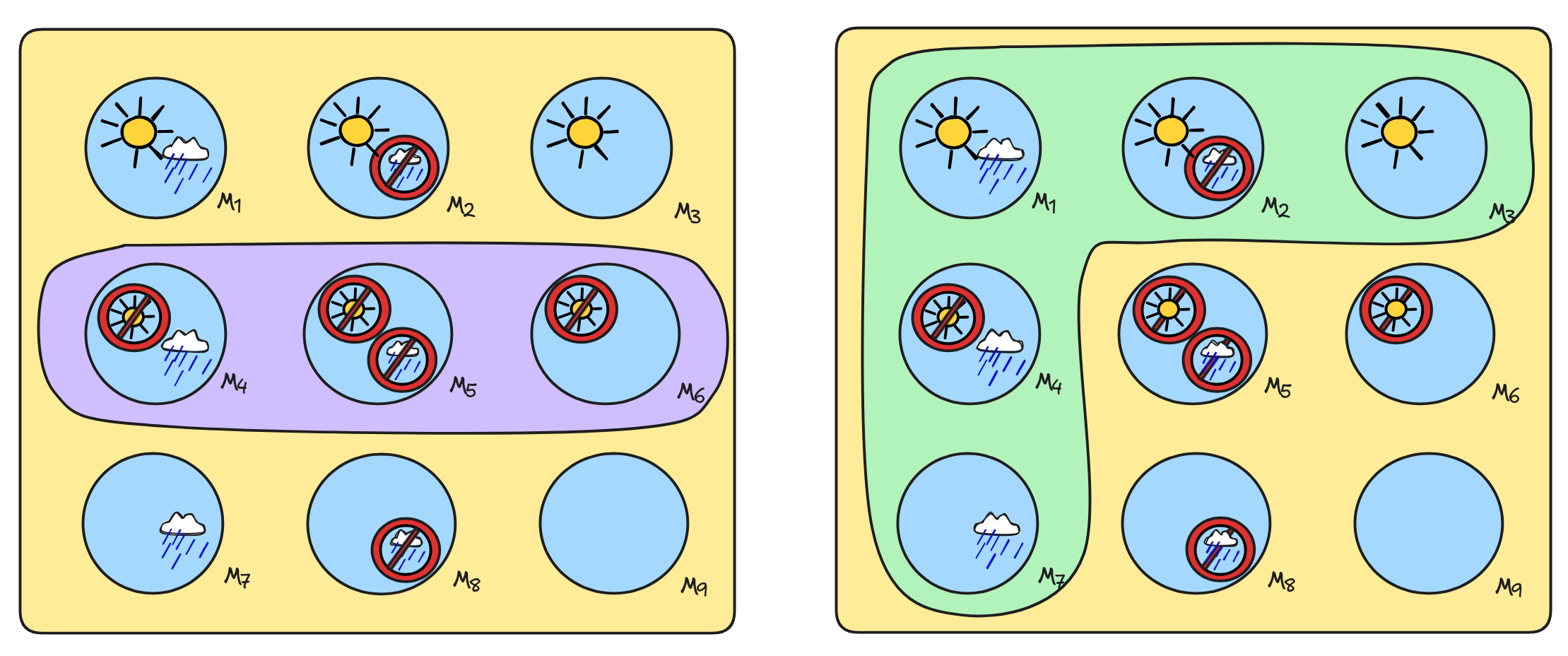
In fact, we can also apply our general blueprint for the definition of logical consequence in K3:
P₁, P₂, …
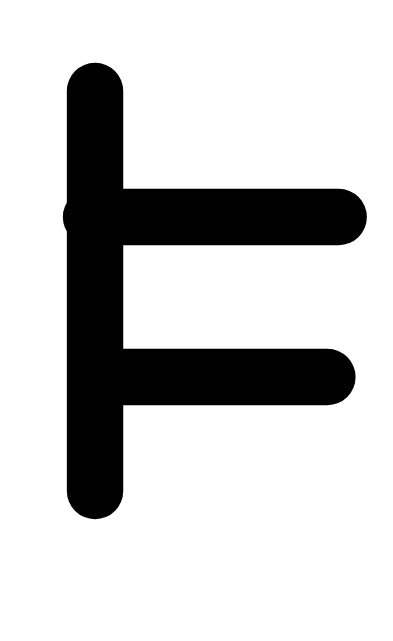 C
C if and only if
 P₁
P₁


 P₂
P₂

 …
…
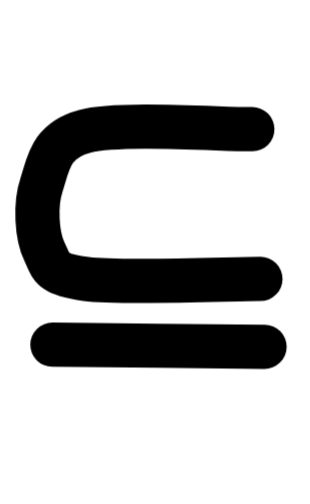
 C
C

We can use this definition, for example, to see that our disjunctive syllogism from before is K3-valid:
 RAIN),
RAIN),
 SUN
SUN
 RAIN
RAINWe can check this by inspecting the following diagram:
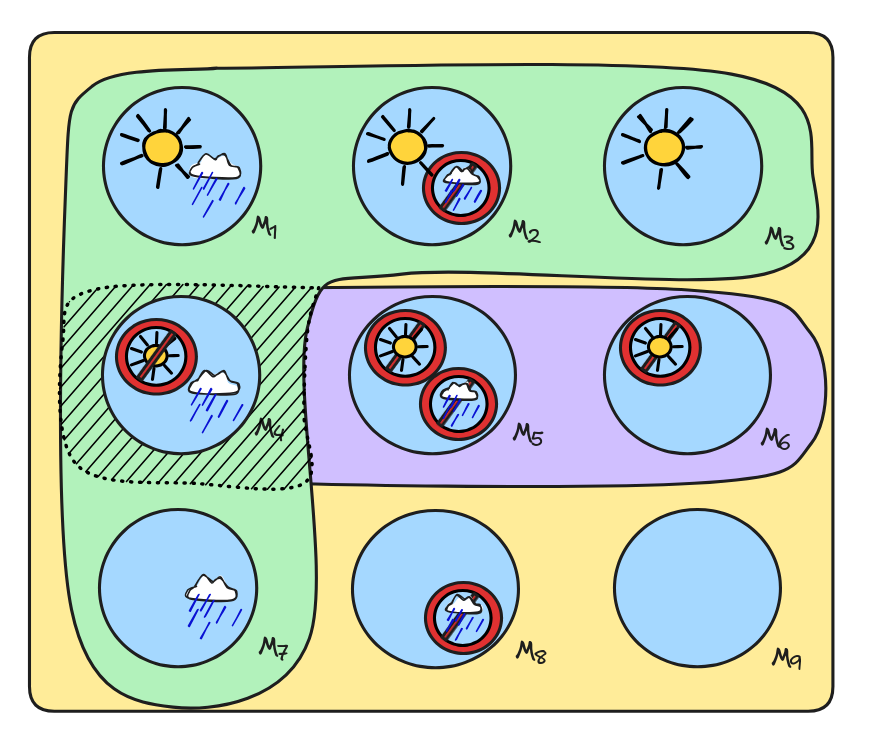
The shaded area is the intersection of

 SUN
SUN


 SUN
SUN
 RAIN
RAIN
 of
of

 SUN
SUN
 and
and
 SUN
SUN
 RAIN
RAIN
 . And
the only model in that intersection is the one where we have the information
that there’s no sun but it will rains, which is a member of
. And
the only model in that intersection is the one where we have the information
that there’s no sun but it will rains, which is a member of
 RAIN
RAIN
 . So, the inference is valid: from the
information that it will be rainy or sunny and that it will not be sunny, we can
infer the information that it will be rainy.
. So, the inference is valid: from the
information that it will be rainy or sunny and that it will not be sunny, we can
infer the information that it will be rainy.
The fact that we get Disjunctive Syllogism in K3 also means that if we interpret the conditional
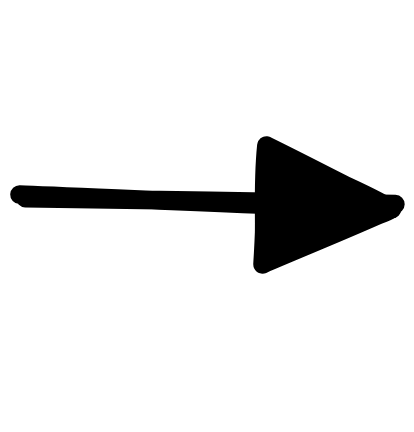 B
B B) = (NOT v(A)) OR v(B),
B) = (NOT v(A)) OR v(B),we get a material conditional that satisfies MP. That means, in turn, that we can use forward chaining and backward chaining with Horn-clauses also in K3. That is, we can use K3 to reason with KBs in the context of potentially incomplete information. Great!
So, you might be wondering what’s the difference to classical logic, then? It turns
out that there are inferences that are classically valid but invalid in K3,
but it’s more instructive to think about
tautologies first, which are
the logical truths of propositional logic—formulas which have the value 1 in
every model. In classical logic, there are plenty of tautologies, such as any
formula of the form A

 A. But, as it turns out, there are
no tautologies in K3. We won’t prove this general fact, but we can check a
simple counter-example of a formula, which is a classical tautology, but not
true in some K3 model.
A. But, as it turns out, there are
no tautologies in K3. We won’t prove this general fact, but we can check a
simple counter-example of a formula, which is a classical tautology, but not
true in some K3 model.
Take the following formula, for example:

 RAIN
RAIN1 in every
classical model. But consider any K3 model, where we don’t have any
information about the rain, that is v(RAIN) = ω. In such a model, we have:

 RAIN) = ω OR (NOT ω) = ω OR ω = ω
RAIN) = ω OR (NOT ω) = ω OR ω = ωBut ω ≠ 1, which means that in any such model, where v(RAIN) = ω, is a model
where RAIN

 RAIN doesn’t have value
RAIN doesn’t have value 1. Under the
information interpretation, this makes quite some sense: it’s not the case that
regardless of which information we have, we either have the information that it
rains or the information that it doesn’t. There are no things that we know
independent of any information.
There are classically valid inferences, which rely on the fact that statements
like RAIN

 RAIN are tautologies, and which fail in K3.
For example, the somewhat random inference:
RAIN are tautologies, and which fail in K3.
For example, the somewhat random inference:
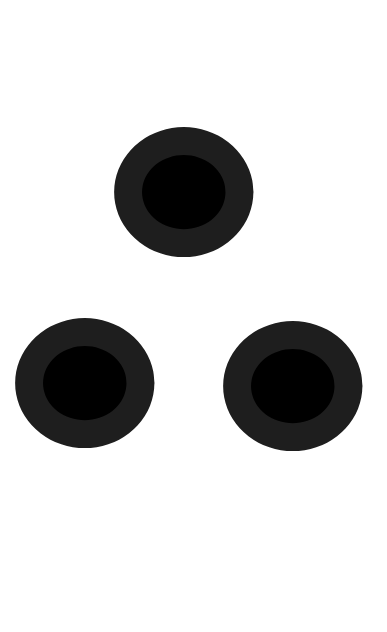 RAIN
RAIN

 RAIN
RAINIf we take a model, where v(SUN) = 1 and v(RAIN) = ω, we’ve got a
countermodel.
Unfortunately, though, the connection between SAT and logical consequence that
we’ve used in Boolean logic and classical FOL doesn’t hold in K3:
P₁, P₂, …
 C
C if and only if not-SAT { P₁, P₂, …,
 C
C }The reason for this is that there in K3, there can be countermodels that don’t
satisfy { P₁, P₂, …,
}. A K3 countermodel is a model where
all the premises are true, but the conclusion isn’t. But that doesn’t mean that
the conclusion is false—it could also be a model where the conclusion is
undetermined. C
C
The model which shows that RAIN

 RAIN doesn’t follow from
SUN in K3, is a case in point: it’s a model where RAIN, and thus
RAIN
RAIN doesn’t follow from
SUN in K3, is a case in point: it’s a model where RAIN, and thus
RAIN

 RAIN is
RAIN is ω. But crucially, the negation of
RAIN

 RAIN, that is
RAIN, that is
 (RAIN
(RAIN

 RAIN), is unsatisfiable—and so is every set that contains it, like
RAIN), is unsatisfiable—and so is every set that contains it, like
 (RAIN
(RAIN

 RAIN) }
RAIN) } (RAIN
(RAIN

 RAIN) have value
RAIN) have value 1, the formula
RAIN

 RAIN would need to have value
RAIN would need to have value 0. But the only way
that could happen, even in K3, is if both RAIN and
 RAIN have
value
RAIN have
value 0, which in K3 as in classical logic is excluded. So,
 (RAIN
(RAIN

 RAIN) }
RAIN) }But that doesn’t mean that we can’t use a SAT-solving style approach. For
example, it’s straight-forward to develop a brute-force truth-table method,
where we generate all the relevant models and check if in the models where the
premises are true, the conclusion is as well. In fact, we can easily illustrate
the idea in SQL.
Take our truth-value DB and consider the following query:

|
|
This query returns all the rows of the table where the Kleene expression
X OR (NOT X)
either returns the value 0 or ω. But that’s just the truth-condition for the
formula RAIN

 RAIN where we let
RAIN where we let v(A) = X. In other
words, the query searches for a countermodel to the formula RAIN

 RAIN. It does find one, and so we can conclude that the formula is not a
K3 tautology.
RAIN. It does find one, and so we can conclude that the formula is not a
K3 tautology.
In a similar way, we can test the inference
 RAIN
RAIN

 RAIN
RAINusing the SQL code:

|
|
You can see for yourself in our db-fiddle.
To conclude our discussion of K3, let’s talk about why K3 is a useful logic in AI-reasoning contexts. We’ve seen that it is intimately connected to low-level information retrieval—queries—with incomplete DBs. But there’s also a high-level connection to popular AI-reasoning methods we’ve discussed before.
Think about forward chaining and backward chaining with KBs containing Horn-clauses, for a moment. Remember our example of a KB for rainbow sightings:
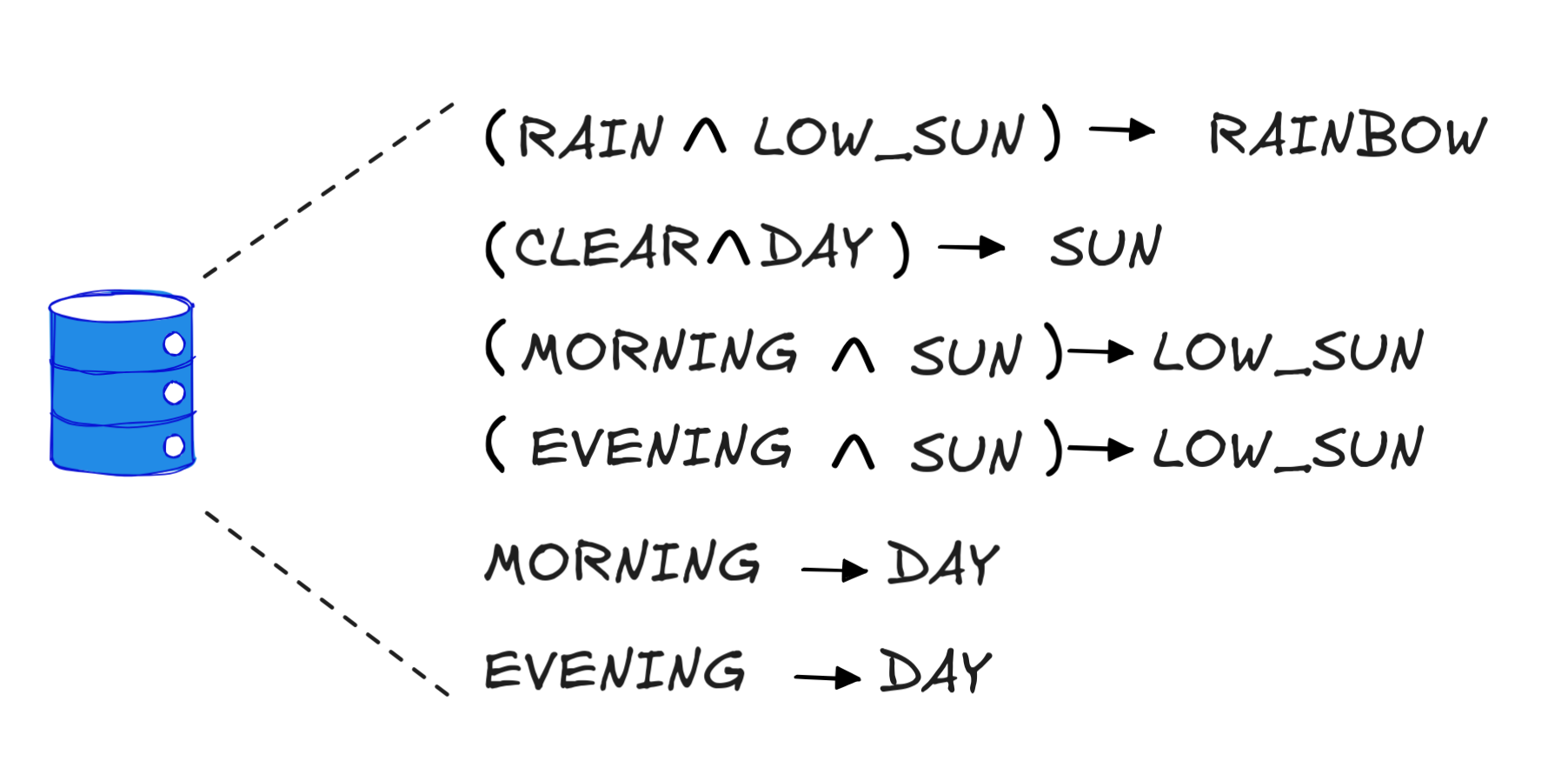
We managed to derive RAINBOW from this using the facts RAIN, MORNING, and CLEAR. In that situation, we concluded that RAINBOW is true—IA will see a rainbow. But we also wondered what we should say if we couldn’t derive RAINBOW—for example, because our facts only contain RAIN, MORNING. Does that mean that we won’t see a rainbow or that we don’t know whether we will?
That depends on the way we interpret our KB: Is it a omniscient collection of all the laws and rules concerning the subject matter—say, all the ways a rainbow can occur? Then, we might be tempted to think that the fact that we can’t derive RAINBOW means that RAINBOW is false. In AI, this is known as the closed-world assumption.
But if our KB is more of a collection of our best understanding of the subject
matter—which may be “gappy” and fail to contain all the true rules, then the
story is different. We’d be doing logical predication under partial uncertainty,
and the fact that we can’t derive RAINBOW would simply mean that we don’t have
enough information to affirm that RAINBOW. If we also can’t derive
 RAINBOW, this would be a very good reason to assign RAINBOW the
value
RAINBOW, this would be a very good reason to assign RAINBOW the
value ω—we don’t know! This is closely related to the so-called open-world
assumption in AI. And for reasoning with KBs—for example as in expert systems
like ours—the logic K3 is ideally suited.
Fuzzy Predicates
Vagueness is a very different
motivation for dropping bivalence and is one of the main motivations for
fuzzy
logic. To illustrate the idea, think
about which temperature means “warm” again. A standard and natural way of
thinking about it is to say that warmth comes in degrees, which we can measure
by a number between 0—meaning definitely not warm—and 1—meaning definitely
warm. So, 0.75 warm means something like definitely more warm than cold, but not
all the way there, while 0.1 warm means not freezing cold, but also barely warm.
If we take this idea seriously and assume a language with three predicates
IsCold, IsWarm, and IsHot, we can assign those predicates values between
0 and 1 when applied to a temperature in order to represent the extend to
which this temperature is considered cold, warm, or hot. One way of assigning
such values is represented in the following diagram:
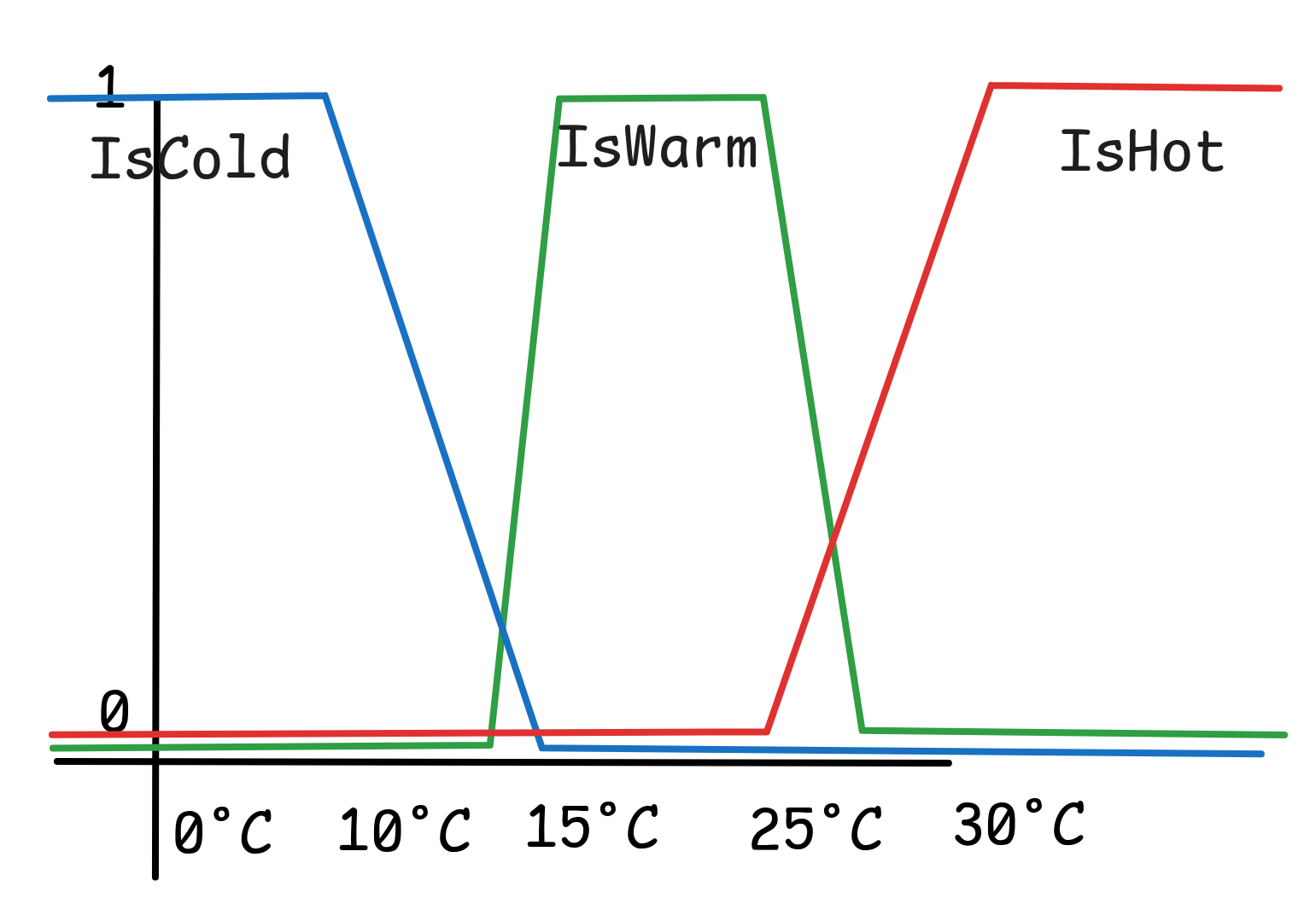
This is the idea of fuzzy predicates: we’ve treated IsCold, IsWarm, and
IsHot as fuzzy predicates of temperature. In contrast, the binary predicates
of classical FOL are also called crisp predicates.
Fuzzy logic deals with inference involving fuzzy concepts. While it is central for many AI-technologies, especially so-called fuzzy control systems, which you find in automotive systems (trains, cars, plains, etc.) or self-regulating thermostats, it turns out to be rather difficult to formulate theory of high-level inference with fuzzy predicates—difficult, though not impossible. Accordingly, we’ll only scratch the surface of fuzzy logic in this chapter, but we’ll illustrate some basic ideas of working with fuzzy predicates, which will come in handy if you ever get your hands dirty with fuzzy AI systems.
For this purpose, we’ll work with the language of FOL but without the quantifiers. For simplicity, we’ll also ban function symbols. That is, for us, the expression
IsWarm 10°C
is a well-formed formula, but
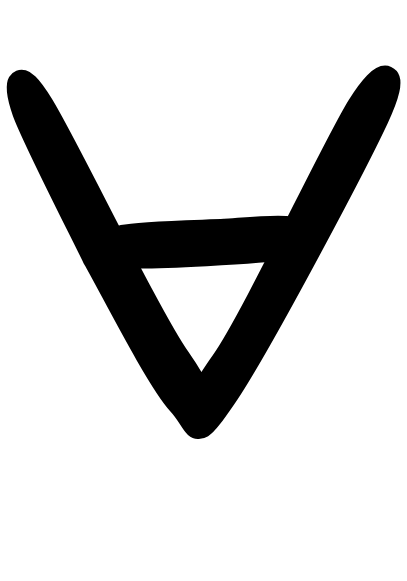 x(x ≥ 10°C
x(x ≥ 10°C
 IsWarm x)
IsWarm x)
is not.
A fuzzy valuation for such a language is defined very similarly to an FOL
model: we have a (non-empty) domain, D, and denotations
 a
a

 D for all the constants. The main difference to an FOL
model is that for the predicates, we don’t assign extensions in the usual
sense—that is sets of objects having the described property—but we associate
with each predicate
D for all the constants. The main difference to an FOL
model is that for the predicates, we don’t assign extensions in the usual
sense—that is sets of objects having the described property—but we associate
with each predicate Pⁿ a function
,
which assigns to all n inputs from the domain a
real
number between 0 and 1
(inclusive). This number measures the extend to which the predicate applies to
these objects. Pⁿ
Pⁿ

That is, if our domain contains all the temperatures, then
 IsWarm
IsWarm
 10°C = 0.01
10°C = 0.01means that in our model 10°C is barely warm. In fact, we’ll continue working
with temperature examples, so we’ll just assume that our domain D contains all
the temperatures and our language has a name for each such temperature: 10°C
for 10°C, 12.75°C for 12.75°C, and so on. That is, our models look like
the diagram above. The extension of the predicates IsCold, IsWarm, and
IsHot in such a model, then, is given by curves like the colored ones
depicted.
The value of an atomic ground formula in such a model is easily defined. We say, for example, that:
 IsHot t
IsHot t
 =
=
 IsHot
IsHot

 t
t

 t
t

is the denotation of the term t,
defined just like in FOL.
The main question we’ll be looking into now is how we can interpret complex fuzzy expresions in such models. What, for example, is the value of the following complex open formula:
IsWarm x
 IsCold x
IsCold x
We want it to be a fuzzy function over the domain, but which one?
The standard way of interpreting such expressions is using the so-called Zadeh-operators, which are named after Lotfi Zadeh, who introduced fuzzy logic to AI-research—even though their logic has already been studied by Łukasiewicz.
The idea is that we can say:

 A
A
 = 1 -
= 1 -
 A
A

 A
A
 B
B
 = min
= min
 A
A

 B
B

 A
A
 B
B
 = max
= max
 A
A

 B
B

Here, min and max are the minimum and maximum function respectively, which return the biggest value among their inputs in the case of max and the smallest input in the case of min.
To see how these work, it might help to look at the outcomes of these operations in the fuzzy model we’ve described above:
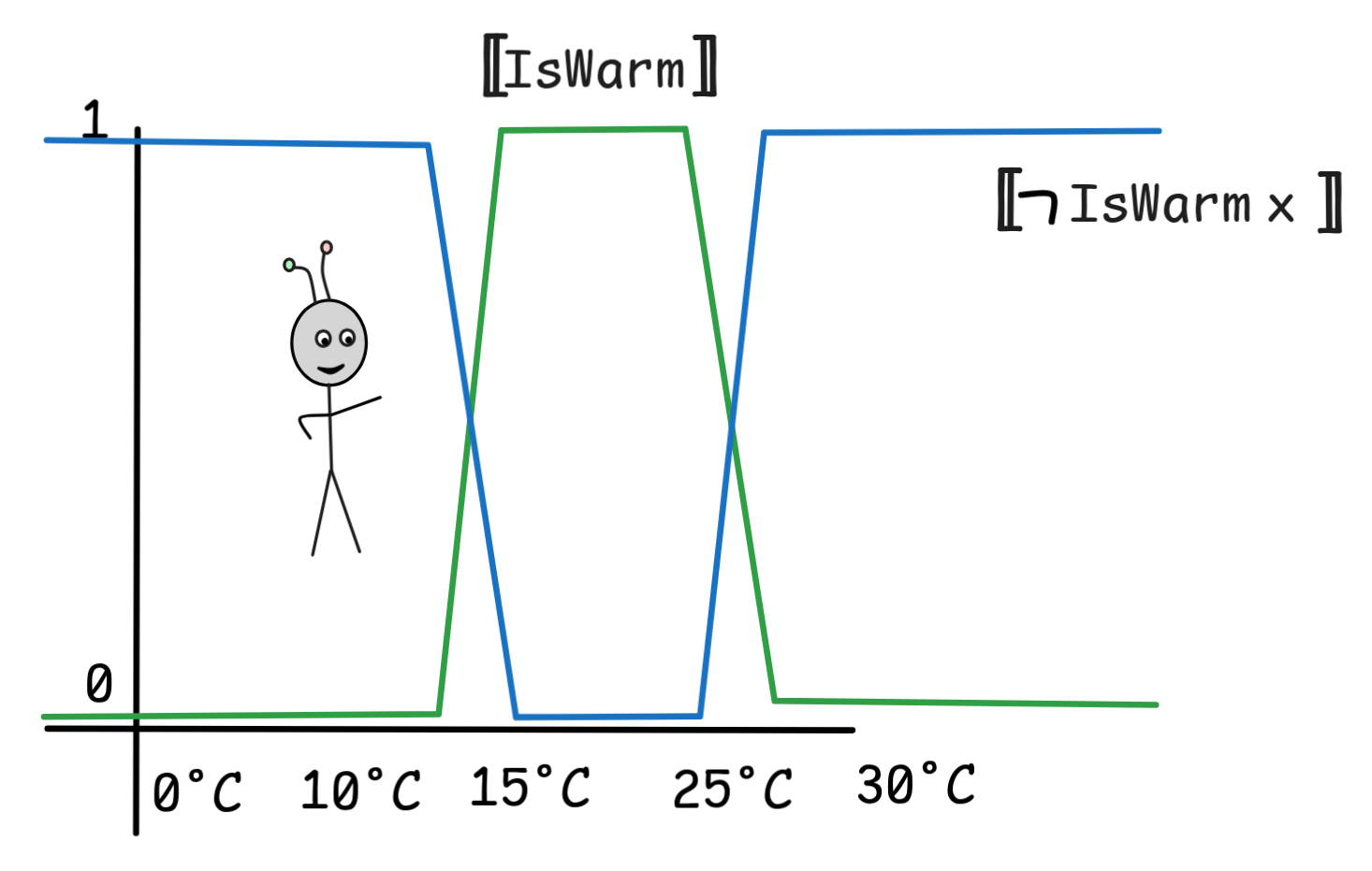
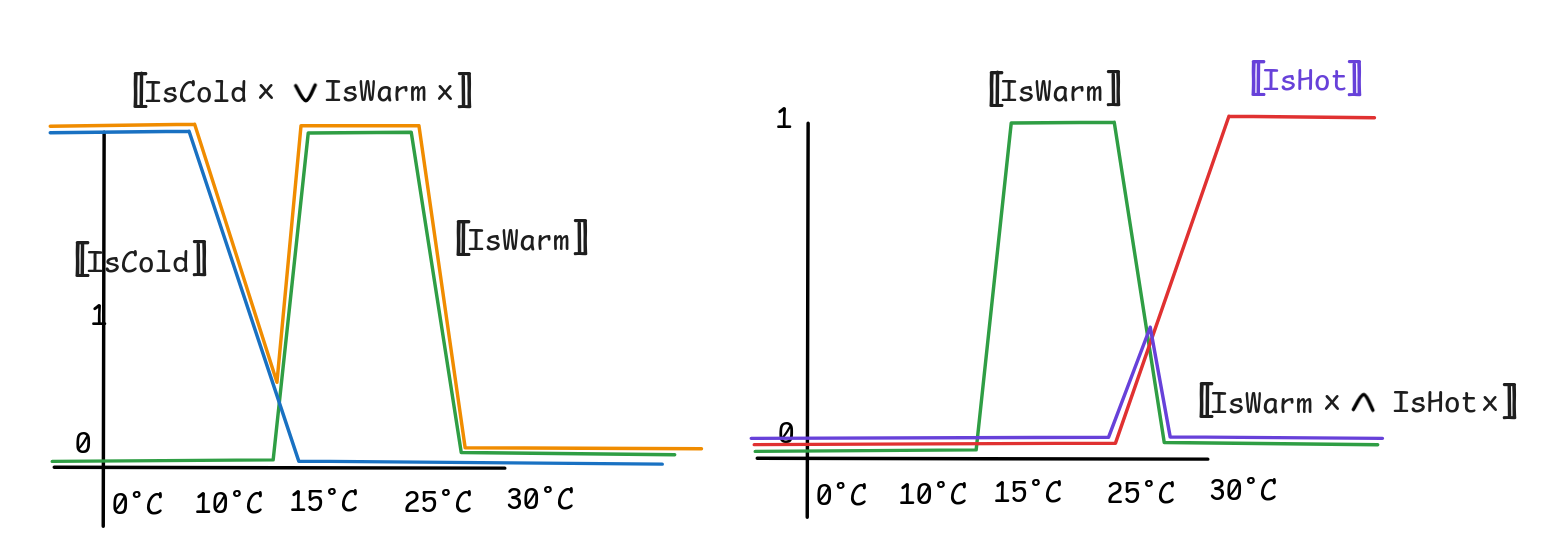
In these models, there is also a natural notion of deductive consequence, which
has already been explored by Łukasiewicz in the 1920s. The idea is that, for
example,
entails, in a sense,
 IsCold 10°C
IsCold 10°C

since
the value of the latter is always at least as high as the value of the former. IsCold 10°C
IsCold 10°C
 IsWarm 10°C
IsWarm 10°C

More generally, we say that a premise
set P₁, P₂, … fuzzy entails a conclusion C just in case for every model, the minimum of the values
is smaller than or equal to the value  P₁
P₁
 ,
,
 P₂
P₂
 , …
, …
,
that is: C
C

P₁, P₂, …
 C
C if and only if, in all models, min {
 P₁
P₁
 ,
,
 P₂
P₂
 , …} ≤
, …} ≤
 C
C

At face value, this definition doesn’t satisfy our blueprint for deductive validity, but using the concept of a T-norm it can be brought much closer to that pattern. But for now, we focus on the above formulation since it gets us much closer to so-called fuzzy rules, which are the basic building block of fuzzy control systems.
Fuzzy Rules
A fuzzy rule is, in essence, a model constraint that enforces that some
conditions—the antecedent of the rule—fuzzy imply (in the above sense) a
conclusion. Typically, we formulate these fuzzy rules using open formulas of
with appropriate free variables. For example, we write the fuzzy rule that
IsHot fuzzy entails AcOn—where AcOn is a fuzzy propositional variable which
just gets a fuzzy value assigned—either as
IF IsHot x THEN AcOn
or using arrow notation as
IsHot x
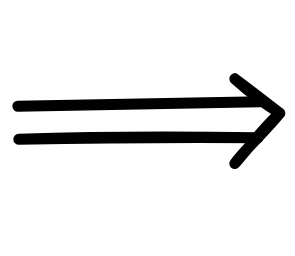 AcOn
AcOn
We postulate that fuzzy rules have a kind of MP property where a model that satisfies a rule just in case for every object in the model, the value of the consequent of the rule applied to the object is at least as big as the value of the premise of the rule applied to it.
Some rules, like
IsHot x
 IsHot x
IsHot x
 IsWarm x
IsWarm x
hold with mathematical necessity—simply because of how the operators are interpreted.
But other rules, we need to enforce. And that’s the idea of fuzzy control systems. Think, for example, of a self-regulating heating system, which aims to keep the warm always warm and cozy, never too hot and never too cold. One way of implementing such a system is by means of a fuzzy rule.
Suppose for the setup that we define our fuzzy predicate IsCold is given by
the above diagram. Then we can implement our fuzzy heater by means of the
following rule:
IsCold x
 HeatingOn
HeatingOn
Here HeatingOn is again a fuzzy propositional variable, which simply gets a
value between 0 and 1 in every model and which represents the extend to
which the heating is engaged.
The idea is to enforce through some mechanism that this rule is satisfied by the
temperature at any given point in time. That is, the system ensures that the
extend to which HeatingOn is true at any time coasts the line IsCold:
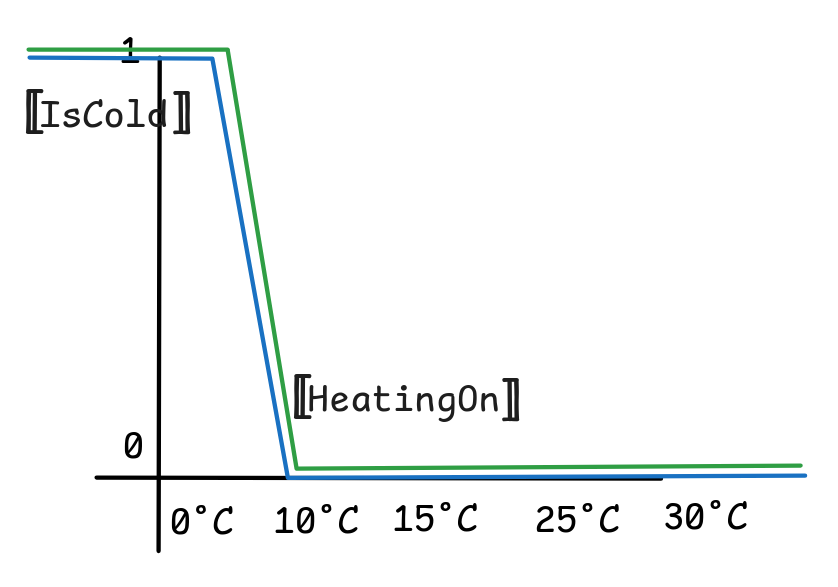
These kinds of fuzzy control systems are industry standard in aviation, space-travel, train regulations, self-driving cars, heating systems, and many more places. One important advantage of such systems as compared to “crisp” systems is that they behave “smoothly”. A crisp thermostat just turns the heating on or off if the temperature falls below a certain threshold. This can be very uncomfortable if the temperature is set to 20°C, it falls to 19.9°C and all of a sudden the heating blasts on full power. A fuzzy control system will only turn the heating on a little bit at 19.9°C and then quickly off again. In this way, fuzzy systems can also be much more efficient than crisp control systems.
This efficiency can be even more noticeable, if we can adjust what IsWarm
means for us. Suppose, for example, that we can set the curve for IsWarm as
follows, while leaving IsCold unchanged:
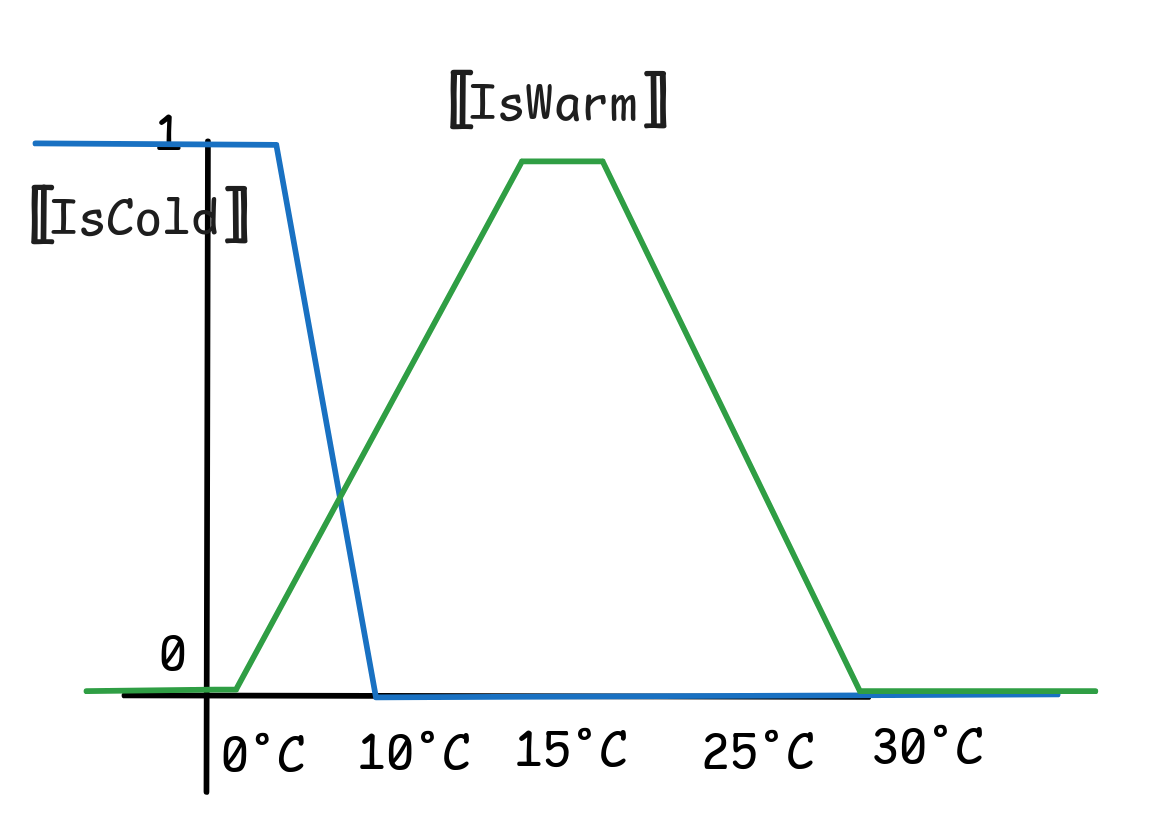
Now, the fuzzy following fuzzy rule
IsCold x

 IsWarm x
IsWarm x
 HeatingOn
HeatingOn
will be more energy efficient than just:
IsCold x
 HeatingOn
HeatingOn
since the former rule will stop heating quicker. Just inspect the following diagram:
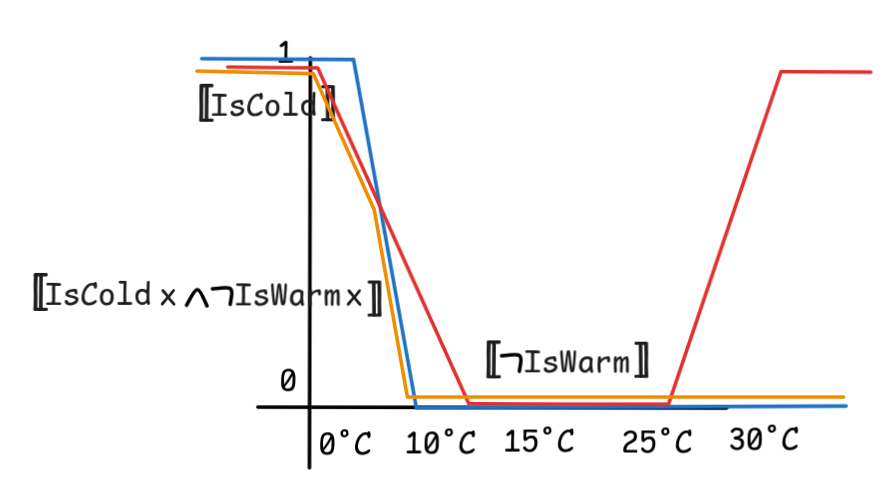
This is just a small teaser of the huger world of fuzzy logic, but I hope it became clear that there are excellent low-level applications of these core logical methods.
Last edited: 14/10/2025